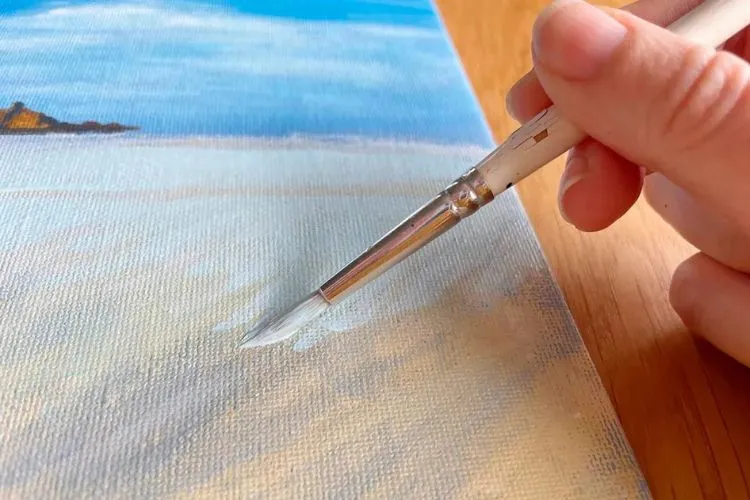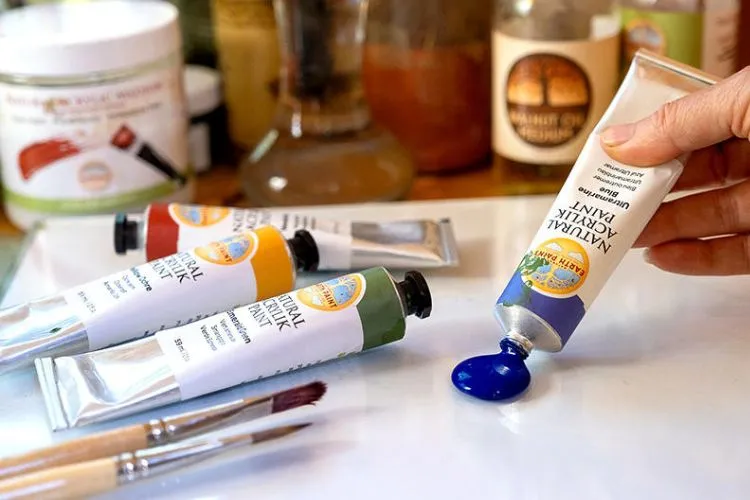Acrylic paint stands out for its versatility, vibrant colors, and fast-drying properties, making it a top choice for many artists.
However, even with its relatively quick drying time, managing and accelerating the process can sometimes be a challenge—especially when working with thicker layers or in humid environments.
Acrylic paint stands out for its versatility and vibrant colors, making it a favorite among artists. Yet, one challenge often encountered is managing its drying time.
This can vary widely, influenced by the paint’s thickness, environmental conditions, and the techniques applied.
This article aims to share practical advice on how to make acrylic paint dry faster, ensuring artists can work more efficiently, especially when time is of the essence.

Understanding Acrylic Paint Drying Times
Acrylic paint dries relatively quickly compared to oils but can still take longer under certain conditions. The drying time is influenced by the paint’s application thickness, the room’s humidity, temperature, and the airflow around the painting.
It’s important to understand the difference between drying and curing: while acrylic paint can dry to the touch in minutes to hours, it may take weeks to fully cure.
How to Make Acrylic Paint Dry Faster?
Adjust the Environment
The environment plays a crucial role in the drying time of acrylic paint. Temperature, humidity, and airflow are all factors that can be adjusted to help speed up the process.
- Temperature: A warm room supports faster drying. Working in an environment that’s too cold can slow down the drying process significantly. Ideally, the room temperature should be kept around 70-75 degrees Fahrenheit.
- Humidity: High humidity slows down drying times by preventing water in the paint from evaporating quickly. Using a dehumidifier or air conditioner to reduce the room’s humidity can help accelerate drying.
- Airflow: Ensuring good airflow can also speed up drying times. A fan set on low can circulate air around the painting without blowing directly on it, which could cause uneven drying or spread dust onto the wet surface.
Use of Painting Mediums
- Thin Layers: Applying paint in thin layers not only allows for quicker drying times but also provides better control over the painting’s texture. Thick applications take significantly longer to dry.
- Drying Mediums: Special drying mediums are available that, when mixed with acrylic paints, can speed up the drying process. These mediums are designed to quicken drying without affecting the paint’s color or integrity.
- Texturizing Additives: While they can create interesting textures, some additives may increase drying time. It’s wise to understand the properties of any additive used to ensure it doesn’t inadvertently slow down your workflow.
Practical Application Methods
- Layering Technique: The layering technique involves applying paint in thin, manageable layers. This not only helps in faster drying but also in achieving depth and richness in the color.
- Hairdryer Method: Using a hairdryer can be a quick fix to speed up drying times. Holding the dryer at least 12 inches away from the painting on a low heat setting can promote drying without damaging the paint.
Pro Tips for Managing Drying Times
Plan your painting sessions, keeping in mind the drying times of different layers and colors. This will help maintain a smooth workflow.
Working in smaller sections allows each part to dry before moving on, preventing smudging and unnecessary touch-ups.

Common Mistakes to Avoid
When working to dry acrylic paint faster, artists should be wary of the following common pitfalls:
- Excessive Heat: Application of too much heat or holding a hairdryer close to the painting surface risks bubbling, cracking, or warping, altering the intended texture and finish of the artwork.
- Direct Airflow: A hairdryer or fan directed straight onto the painting can push the wet paint, causing unsightly streaks or splatters that may ruin the piece’s composition.
- Layer Thickness: Piling on too much paint to create texture may backfire, as overly thick layers take much longer to dry and could even remain tacky, collecting dust and debris.
- Rush Drying: Attempting to accelerate the drying process excessively may lead to impatience and rushed decisions that compromise both the aesthetic and structural integrity of the paint.
- Neglected Environmental Factors: Ignoring room temperature and humidity levels can prolong drying times despite efforts to quicken the process using additional tools or techniques.
By avoiding these missteps, artists can ensure a smoother, faster drying time without sacrificing the quality and longevity of their acrylic paintings.
Safety Precautions When Drying Acrylic Paint
When attempting to expedite the drying process of acrylic paint, it’s vital to employ safety precautions, especially when involving drying mediums, heat sources, and electrical appliances.
Misuse of hairdryers or fans not only poses a risk of damaging the artwork through uneven drying or contamination with dust but also presents safety hazards. Overheating paint can release fumes, while electrical appliances near paint or solvents create a fire risk.

Always maintain a safe distance when using heat sources, ensuring they’re on a low setting to prevent the paint from bubbling or cracking. Additionally, ensure good ventilation to disperse any vapors released from mediums or heated paint.
Following manufacturer instructions for mediums and additives is crucial to avoid adverse chemical reactions. Remember, safety not only preserves the integrity of your artwork but also protects you from potential harm.
You may also read: Is Acrylic Paint Durable Outside? The Ultimate Guide
Frequently Asked Questions (FAQs)
Can additives affect the color or texture of the acrylic paint?
Yes, certain mediums can alter the appearance or finish of the paint. It’s important to experiment on small samples before applying these to your main work to ensure the desired effect is achieved.
How can I tell if the paint is dry?
The surface may be dry to the touch, but it doesn’t mean the paint is fully cured. Acrylic paint can take up to three weeks to cure completely. Gently touching the surface can help determine if it’s dry. Avoid pressing hard as this might leave fingerprints or marks.
Is it possible to speed up the drying of very thick layers or textures?
Thick layers will inherently take longer to dry. Adjusting the environment by increasing airflow and reducing humidity can help. However, it might be necessary to plan for longer drying times when working with thick textures.
Will speeding up the drying process affect the longevity of my artwork?
Using harsh methods or too much heat can potentially damage the paint, affecting both the appearance and durability of the artwork. It’s vital to use gentle methods and follow manufacturer recommendations for mediums and additives.
Conclusion:
Accelerating the drying time of acrylic paints involves a balance between environmental adjustments, application techniques, and the use of specific mediums.
By understanding the factors that influence drying times, artists can employ methods that complement their workflow without compromising the quality of their artwork.
Experimentation and patience are key, as each project may require a different approach to achieve the desired results.

Meet Isabella Anderson, your acrylic painting mentor with over a decade of brush-wielding mastery. Dive into the colorful world of acrylics with her expert guidance, featured exclusively on ‘Acrylic Authority.’ Unleash your inner artist and explore the limitless possibilities of this versatile medium alongside a true acrylic aficionado.
